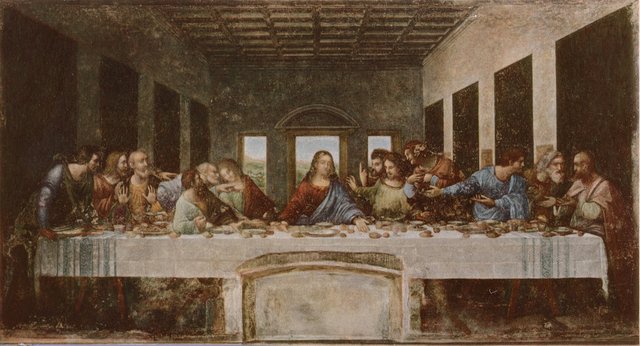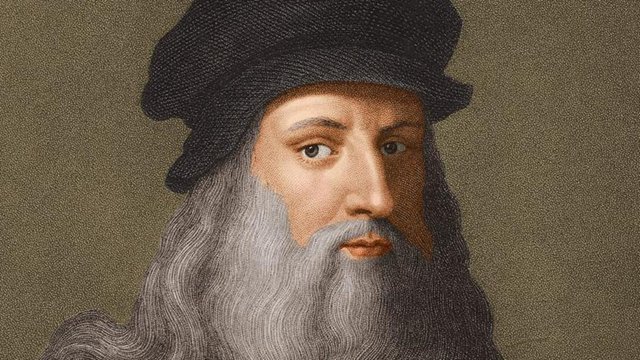Today in Christian History.

“Creativity is not a mood. Creativity is not a gift. It’s the very nature of God inside you.”
-Dan McCollam
Our world is a masterpiece and God is the great artist. Creativity is a large aspect of the spark of God’s image in us. Therefore, art in its purest form brings glory to God. Not only is art a form of worship itself, it can also lead others to worship God. There is no better example of this than in the case of Leonardo Da Vinci’s The Last Supper.
The painting was commissioned by the duke of Milan, Ludovico Sforza, in 1495. The 15-foot by 29-foot masterpiece was painted in the dining hall at the Santa Maria Delle Grazie monestary in Milan, Italy.
The painting depicts the moment after Jesus declares that one of the disciples will betray him to his death (Matthew 26:21-28). Da Vinci vividly portrays the reactions of Jesus’ closest friends at this shocking revelation. The expressions and stance of each disciple is closely linked to their personalities. Unlike in other 15th century paintings, Jesus does not have a halo. It seems that Da Vinci was attempting to ground his painting in reality and emphasize Jesus’ humanity.
The Last Supper has been an inspiration to thousands of Christians in the following centuries. One can sense the shock and grief of the disciples as well as the courage and serenity of Christ in a way that transcends the power of words.

Unfortunately, the painting has deteriorated over the years. Grime, dirt, mold, and ashes have discoloured the work. In the 17th century, a door was cut into the wall that destroyed a portion of the painting. Napoleon’s army used the room as a stable, contributing to its decline. In World War II, a bomb destroyed the roof and one wall of the room—exposing the painting to the elements for several months.
In the 1970s, several artists undertook the painstaking task to restore the aging masterpiece. The colours were revitalized and missing areas were replaced in a process that lasted 20 years. On May 28th, 1999, the Last Supper was, once again, opened to the public.
Verse of the day: Isaiah 64:8
But now, O LORD, you are our Father; we are the clay, and you are our potter; we are all the work of your hand.
Dear @thecruciformlife,
The Da Vinci painting of the "Last Supper" is truly a masterpiece.
Leonardo da Vinci’s painting of the Last Supper has riveted the minds of the world for centuries. Yet this depiction of the Last Supper, like many others, is quite inaccurate when it comes to the actual setting of the Last Supper. Because of these depictions, we often picture Christ seated at the center of a long table, with his disciples on each side of him.
However, according to ancient Roman and Jewish culture, and several verses found in the gospels, we find a much different setting.
The home would have been a wealthy home, as it had an upper chamber, and all of the preparations for the Passover feast would have already been made. The most prominent feature of the room would have been a low table in the shape of a “U” called a triclinium.
A triclinium was a Roman styled table, of various sizes and styles, that had been adopted by the Jews of the first century. The table had large couches, or cushions, placed on each of the three sides, allowing the middle to be open for entertainment and servers.
The guests would lay on their left side facing the inside, leaving their right hand free to eat the meal. This would mean that each guest could lean on the bosom of the person to their left. Their legs would be towards the outside, allowing a servant to wash their feet as they ate the feast, similar to when Jesus’ feet were washed by the penitent woman in Luke chapter seven.
The host of the feast would not sit in the middle, as is often depicted in artwork of the Last Supper, but instead second to the left, with the guest of honor on his left, and a trusted friend to his right. The seating then continued around the triclinium, the most important guests seated on the left, then going around the table, with the least important sitting on the far right. The servant, if seated at the table, would occupy the last position, closest to the door, so they could go and obtain more food as the evening progressed.
Shalom, Steven Sherman @lastdays
Downvoting a post can decrease pending rewards and make it less visible. Common reasons:
Submit
Very interesting information. Quite helpful. I think one reason that Da Vinci painted the table in the way that he did was for a deliberate effect. It was painted on the wall of the dining hall of the monastery. The tables would have been lined up in parallel next to the wall and the painting. The table was painted in such a way so as to create an illusion that Jesus and the disciples were eating in the dining hall among the monks.
That really is fascinating information regarding the real event though. I appreciate your well thought out comments my friend, keep it up. I enjoy your posts as well.
Downvoting a post can decrease pending rewards and make it less visible. Common reasons:
Submit
Dear @thecruciformlife,
Thank you for your kind and gracious reply to my comment.
I did not know that Da Vinci painted in a way to create an illusion that the monks would be dining with Jesus and His apostles. Very fascinating!
Blessings in Yeshua, Steven Sherman @lastdays
Downvoting a post can decrease pending rewards and make it less visible. Common reasons:
Submit
There are many mysteries and secrets that involve the development of this work, incoherent data, for that reason has been the subject of various studies and interest of many.
A fact that once called my attention is the following: the same person who served as a model for Jesus, was the same person for Judas model.
Downvoting a post can decrease pending rewards and make it less visible. Common reasons:
Submit
I don't think it's a masterpiece at all. It's totally inaccurate. Jesus was Jewish. He didn't have long hair like a woman. That would have been shameful. Jesus would have had short black hair. He would have had a long beard like a rabbi. The disciples didn't sit in chairs at a tall table but they reclined at a short table.
Downvoting a post can decrease pending rewards and make it less visible. Common reasons:
Submit
Yeah. Da Vinci didn't have all that information, and frankly, he probably wouldn't have been very interested in that information at all. Is that reason enough to say that it isn't a masterpiece? In our society we're trained to see all of history through the lens of racial and gender groups fighting for dominance over others. Many look at this painting and see only an offensively white-washed version of near-east culture that seeks to assert the dominance of white European culture. That's not at all what Da Vinci is trying to do or thinking of. There is so much symbolism and character development and spiritual weight behind this picture that you are in serious danger of completely missing out on.
Downvoting a post can decrease pending rewards and make it less visible. Common reasons:
Submit
I personally disagree with this painting. I think the last supper happened under different settings. Check the Bible and history for clearance.
Thanks
Downvoting a post can decrease pending rewards and make it less visible. Common reasons:
Submit
What do you mean you do disagree with the painting? Certainly its not totally accurate. Its clear that Da Vinci was no scholar of ancient eastern culture. Is that reason enough to "disagree" with the painting itself? Try to look to what Da Vinci is really trying to say through his work.
Downvoting a post can decrease pending rewards and make it less visible. Common reasons:
Submit